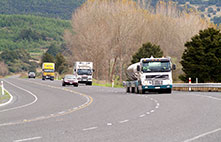What is the difference between passing and overtaking?
Passing is when the driver of slower vehicles uses passing facilities (such as passing lanes, slow vehicle bays and diagonally marked sealed shoulders) to let faster following vehicles pass.
Overtaking is when the driver crosses the centre line and uses the opposing traffic lane to pass a slower vehicle.
These New Zealand definitions are different from the Austroads definitions.

Example of passing |

Example of overtaking |
The key elements of this policy are:
retain/enhance overtaking opportunities both at low flows and in conjunction with passing lanes
optimise the use of passing facilities in terms of design and location
provide an intermediate treatment between passing lanes in series and four-laning (ie 2+1 lanes, which are continuously alternating passing lanes)
apply supporting treatments and measures that assist or act as alternatives to passing and overtaking treatments.
The main purpose of this policy is to improve travel time delays and passing-related safety on the existing two-lane rural state highway network, until the point where four-laning is likely to be required. Rural state highways have speed limits of 80km/h or more.
The policy does not apply to the roads of national significance, existing or proposed rural four-lane road sections and urban state highways.
The rural two-lane state highway network carries about 30% of New Zealand’s total annual road travel, as measured in vehicle kilometres travelled (vkt). So the passing and overtaking policy has important implications for:
reducing travel time delays
reducing fatal and serious crashes.
The policy also contributes to:
improvements to freight supply chains
better use of existing infrastructure
value for money.
The Transport Agency has undertaken research into projected traffic flows based on long-term trends. These projected traffic flows are shown in table 1.
| Annual average daily traffic (vpd) |
Estimated 2010
(km) |
Estimated 2040
(km) |
|---|---|---|
| 10,000-25,000 |
400
|
1200
|
| 4000-10,000 |
2300
|
3200
|
| < 4000 |
7200
|
5500
|
| Total |
9900
|
9900
|
Table 1: Length of rural two-lane SH with estimated 2010 and 2040 flows.
The policy enables incremental development in small capacity steps. Given the uncertainty in projected future traffic flows, road sections will be progressively developed in 10-year intervals towards a 30-year layout. By monitoring traffic flows, these 10-year interim strategies should closely match projected traffic growth and help to minimise the risk of over-development.
As New Zealand's economy grows, there is likely to be an increase in the proportion of slow moving vehicles using our rural state highways. Typical slow moving vehicles particularly on steeper gradients include: long-haul freight trucks, logging trucks, milk tankers, tourist coaches and tourist camper vans.
The passing and overtaking policy will help these different types of activities and their associated slow-moving traffic to operate without adversely affecting other faster moving traffic using the same state highways.
Passing and overtaking plans are prepared for individual sections of rural two-lane state highway. These plans outline an identified interim (10-year) programme of works and activities, which leads towards a long-term (30-year) strategy.
For more detail, refer to Regional passing & overtaking plans: A bridge between high-level policy and localised solutions.